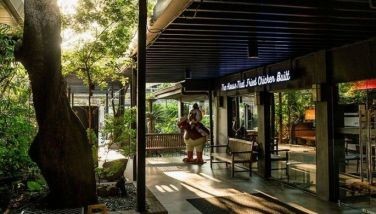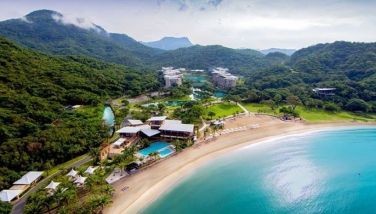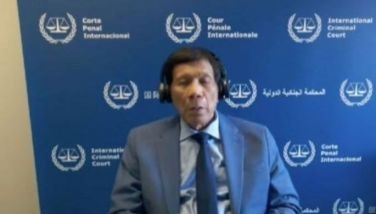China under fire in US Congress
WASHINGTON – If China tries to prevent the re-supply of the grounded Philippine naval vessel BRP Sierra Madre at Ayungin Shoal, then the United States might not only offer to re-supply it, but may consider deploying a few Marines on rotation as part of training, said Patrick Cronin, senior director of the Asia-Pacific Security Program Center for a New American Security.
He said this is one of the actions the US can take to counter potential regional instability.
Testifying on America’s security role in the South China Sea at a hearing of the US House subcommittee on Asia and the Pacific on Thursday, Cronin said China’s assertiveness, its rapid military modernization and its island building program in the South China Sea directly undermined both the post-World War II order and American credibility.
“China’s use of all instruments of power and incremental salami slicing tactics are out-maneuvering the competition,” he said.
The rusting Sierra Madre, a former US Navy transport ship deliberately beached on Ayungin (Second Thomas) Shoal in 1999 and used as a marine outpost in the West Philippine Sea, is on the frontlines of an increasingly tense dispute between the Philippines and China.
Ayugin, which forms part of the Spratly island group, is being claimed in its entirety by China and in its various parts by the Philippines, Vietnam, Malaysia, Brunei and Taiwan.
Andrew Erickson, an associate professor at the China Maritime Studies Institute at the US Naval War College, said that since 2014, China has greatly accelerated its “island building” activities, developing land features in the Spratlys and Paracels that its neighbors simply cannot match.
“Features is the key word here, because many were previously small rocks or reefs not legally considered islands,” he said.
But it’s what China is constructing atop these artificial features that most concern its neighbors and the United States: militarily relevant facilities, including at least two runways capable of serving a wide range of military aircraft.
There’s no need for a 3,000-meter runway – as China now has on Woody Island in the Paracels and Kagitingan (Fiery Cross) Reef – to support evacuation of personnel for medical or weather emergencies, he said.
Such a runway is only needed to support a full range of military options. Building a separate taxiway alongside, as China has already done at Kagitingan Reef, suggests plans for high tempo, high sortie rate military operations.
Not one of the other South China Sea claimants enjoys even one runway of this caliber on any of the features that it occupies, he said.
Mira Rapp-Hooper, director of the Asia Maritime Transparency Initiative at the Center for Strategic and International Studies (CSIS), said China is the only country among the claimants to have completely transformed features formerly under water into artificial islands.
Other countries have used the technique to add some additional acreage onto features already above water.
She said a Southeast Asia Reassurance Fund proposed by the Senate Armed Services Committee with an initial budget of $50 million this year could provide much needed support to the coast guards and navies of other South China Sea claimants.
Michael Swaine of the Asia Program at the Carnegie Endowment for International Peace has called on China and the US to dial down the heated rhetoric.
Allowing a dispute over a few rocks and islands in a corner of the Asia-Pacific region to derail a vital relationship is the height of folly, he said.
Hyperbolic statements, veiled threats and calls for more military action serve no useful purpose and will only lead to hardened positions and redoubled efforts on both sides to counter the other, he added.
He claimed Washington’s message on the South China Sea issue has been badly garbled, making it sound like it is opposed to any Chinese activities that involve an increase in presence or capability in the area, with little serious reference to actions of any other claimants – particularly Vietnam and the Philippines – that China may find provocative.
This issue and the need for greater clarity regarding concerns and consequences should be addressed to justify discussion at the highest levels of government and included in the agenda when President Barack Obama meets with Xi Jinping during the Chinese leader’s state visit to Washington in September, Swaine said.
The US and China must build the basis for demilitarizing the region and defusing the escalating tensions, he said.
Influencing tribunal
In Beijing, China’s Foreign Ministry said the US was trying to influence Manila’s arbitration case after a senior US official said China would be obligated to abide by the tribunal’s decision.
China has for years insisted that disputes with rival claimants to the South China Sea be handled bilaterally.
But this month, its claims came under international legal scrutiny for the first time when the Permanent Court of Arbitration in The Hague began hearing a suit the Philippines filed in 2013.
China has refused to take part in the case.
US Assistant Secretary of State Daniel Russel told a conference in Washington this week that as both Beijing and Manila are signatories to the UN Convention on the Law of the Sea, legally they have to abide by the tribunal’s decision.
“Attempting to push forward the arbitration unilaterally initiated by the Philippines, the US side just acts like an ‘arbiter outside the tribunal,’ designating the direction for the arbitral tribunal established at the request of the Philippines,” it said.
“This is inconsistent with the position the US side claims to uphold on issues concerning the South China Sea disputes,” the ministry added, calling on Washington to live up to its promises and not take sides.
Amphibious tank
Meanwhile, state media and intelligence websites have reported the launch of China’s newest battle tank-carrying landing craft air cushion (LCAC) in a recent amphibious landing exercise in Hainan Island in the disputed West Philippine Sea (South China Sea).
Citing a July 20 footage of Chinese state television CCTV, IHS Jane’s said the People’s Liberation Army-Navy featured one of its Zubr-class land LCAC – reportedly the largest of its kind – during drills apparently conducted in Hainan Island, known to be the base of the PLAN’s South Sea Fleet.
The Hainan provincial legislature earlier approved a rule requiring all fishing vessels to seek permission to enter waters within its so-called jurisdiction.
The drills carried out earlier this month involved an “assault force” of amphibious combat vehicles. – Paolo Romero, Mike Frialde
- Latest
- Trending



























